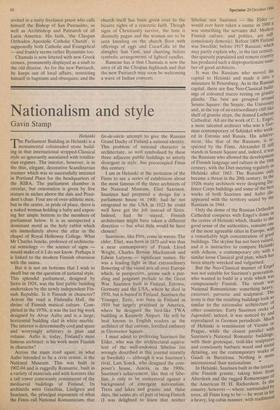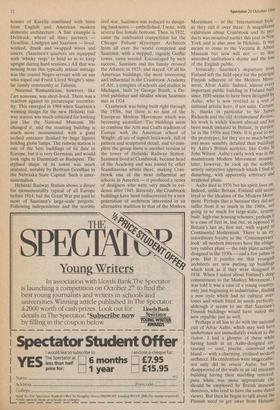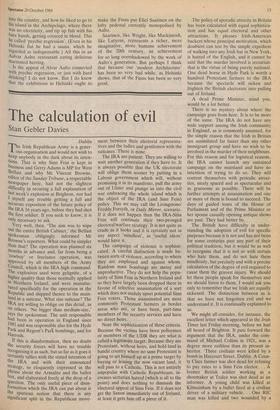Nationalism and style
Gavin Stamp
Helsinki Fr he Parliament Building in Helsinki is a 1 monumental colonnaded stone build- ing in that international stripped-Classical style so ignorantly associated with totalita- rian regimes. The interior, however, is in the thin, elegant, decorative Scandinavian manner which was so successfully imitated in Portland Place for the headquarters of the RIBA. The parliament chamber is circular, but orientation is given by five statues in niches above the dais and Presi- dent's chair. Four are of over-athletic men, but in the centre, in pride of place, there is a naked woman holding a baby and expos- ing her ample bottom to the members of parliament below. It is as unexpected a dominant motif as the holy rabbit which sits immediately above the altar in the chapel of Royal Holloway College. What Mr Charles Jencks, professor of architectu- ral semiology — the science of signs would make of it I do not know. Perhaps it is linked to the modern Finnish obsession with the sauna.
But it is not on bottoms that I wish to dwell but on the question of national style. This splendid parliament, designed by Siren in 1924, was the first public building undertaken by the newly independent Fin- nish Republic. Is it Finnish in character? Across the road is Finlandia Hall, the shrine of Finnish musical culture. Com- pleted in the 1970s, it was the last big work designed by Alvar Aalto and is a large, horizontal building clad in white marble. The interior is determinedly cool and spare and worryingly arbitrary in plan and volume. Aalto is, today, Finland's most famous architect: is his work more Finnish in character?
Across the main road again, in what Aalto intended to be a civic centre, is the National Museum. This was built in 1902-04 and is ruggedly Romantic, built in a variety of materials and with features like a tall tower consciously reminiscent of the mediaeval buildings of Finland. Its architects were Gesellius, Lindgren and Saarinen, the principal exponents of what the Finns call National Romanticism, that
fin-de-siecle attempt to give the Russian Grand Duchy of Finland a national identity. This problem of national character in architecture, so well symbolised by these three adjacent public buildings so utterly divergent in style, has preoccupied Finns this century.
I am in Helsinki at the invitation of the Finns to see a series of exhibitions about the most famous of the three architects of the National Museum, Eliel Saarinen. Saarinen had prepared a design for a parliament house in 1908; had he not emigrated to the USA in 1923 he could well have got the job instead of Siren. Indeed, had he stayed, Finnish architecture might have taken a different direction — but what style would he have chosen?
Saarinens, like Pitts, come in waves. The elder, Eliel, was born in 1873 and was thus a near contemporary of Frank Lloyd Wright, Charles Rennie Mackintosh and Edwin Lutyens — significant names. He was a leading light in 'that extraordinary flowering of the visual arts all over Europe which, in perspective, seems such a puz- zling and poignant prelude to the Great War. Saarinen built in Finland, Estonia, Germany and the USA, where he died in 1950, but is buried in Finland. Saarinen the Younger, Eero, was born in Finland in 1910 but largely practised in America, where he designed the bird-like TWA building at Kennedy Airport. He will be best known to English readers as the architect of that curious, fortified embassy in Grosvenor Square.
I must admit to preferring Saarinen the Elder, who was the architectural equiva- lent of the well-endowed Sibelius (so wrongly described in this journal recently as Swedish) — although it was Saarinen's rival, Lars Sonck, who designed the com- poser's house, Ainola, in the 1900s. Saarinen's achievement, like that of Sibe- lius, is only to be understood against a background of emergent nationalism. Trees and lakes and granite and, these days, the sauna are all part of being Finnish (I was delighted to learn that neither Sibelius nor Saarinen — the Elder would ever have taken a sauna: in 1900 it was something the servants did. Modern Finnish culture, and politics, are self- consciously demotic). Before 1809 Finland was Swedish; before 1917 Russian; which may partly explain why, in the last century, this sparsely populated and remote country has produced such a disproportionate num' ber of good architects. It was the Russians who moved the capital to Helsinki and made it into a miniature St Petersburg. As in the Russian capital, there are fine Neo-Classical build- ings of coloured stucco resting on granite plinths. The best are grouped around Senate Square: the Senate, the University and, at the top of an extraordinary cliff-like shelf of granite steps, the domed Lutheran Cathedral. All are the work of C. L. Engel' a most talented architect who was a Ger- man contemporary of Schinkel who work" ed in Estonia and Russia. His achieve- ment, like that of the Russians, is re- spected by the Finns. Alexander II still stands in Senate Square and, indeed, it was the Russians who allowed the development of Finnish language and culture in the 19th century, with the Diet meeting regularly to Helsinki after 1863. The Russians onlY became a threat in the 20th century. In the 1920s many architects were designing De- fence Corps buildings and some of the best works of both Saarinen and Aalto dis- appeared with the territory seized by the Russians in 1944. Only the dome of the Russian Orthodox Cathedral competes with Engel's dome in the centre of Helsinki which, thanks to the good sense of the authorities, remains one of the most agreeable cities in Europe, with a remarkably high concentration of goo' buildings. The skyline has not been ruined, and it is instructive to compare Helsinki with Athens, a contemporary city with a similar loose Classical grid plan, which has been utterly wrecked and vulgarised. But the Neo-Classical manner of Engel was not suitable for Saarinen's generation, who wanted to build in a style which was conspicuously Finnish. The result was National Romanticism: something heavy, extrovert, perverse arid sculptural. The irony is that the resulting buildings look so similar to the nationalist architecture of other countries. Early Saarinen reeks of Jugendstil; indeed, it was noticed by and reproduced in German periodicals. Much of Helsinki is reminiscent of Vienna or Prague, while the closest parallel with Saarinen's National Romantic buildings, with their grotesque, troll-like sculptures, and consciously barbaric wood and metal, detailing, are the contemporary works of Gaudi in Barcelona. Nothing is more international than nationalism. In Helsinki, Saarinen built in the intract- able Finnish granite, taking hints from c Aberdeen and the rugged Romanesque 01 the American H. H. Richardson. In the country, however — where, surrounded by trees, all Finns long to be — he went in for, a heavy, log cabin manner, with traditional
houses of Karelia combined with hints from English and American modern domestic architecture. A fine example is Hvittrask, where all three partners — Gesellius, Lindgren and Saarinen — lived, worked, drank and swapped wives and sisters. (Saarinen's quarters are equipped with 'whisky rings' to hold so as to keep upright during hard sessions.) All that was missing from this typically artistic ménage was the crazed Negro servant with an axe who wiped out Frank Lloyd Wright's simi- lar family community at Taliesin.
National Romanticism, however, like l'art nouveau, was short-lived. There was a reaction against its picturesque eccentric- ity. This emerged in 1904 when Saarinen's winning design for the new Helsinki rail- way station was much criticised for looking just like the National Museum. He changed it, and the resulting building is much more monumental, with a giant arched entrance flanked by huge figures holding globe lamps. The railway station is one of the best buildings of its date in Europe, but it is very Germanic and would. look right in Darmstadt or Budapest. The stylised shape of its tower was much imitated, notably by Bertram Goodhue in the Nebraska State Capitol. Such is inter- nationalism.
Helsinki Railway Station shows a desire for monumentality typical of all Europe before 1914, but the Great War put paid to most of Saarinen's large-scale projects. Following independence and the terrible
civil war, Saarinen was reduced to design- ing banknotes — embellished, I note, with several fine female bottoms. Then, in 1922, came the celebrated competition for the Chicago Tribune skyscraper. Architects from all over the world competed and Saarinen, with a stepped, vaguely Gothic tower, came second. Encouraged by such success, Saarinen and -his family crossed the Atlantic in 1923, and stayed. Of all his American buildings, the most interesting and influential is the Cranbrook Academy of Art, a complex of schools and studios in Michigan, built by George Booth, a De- troit publisher and idealist whom Saarinen met in 1924.
Cranbrook was being built right through the 1930s, but there is no hint of the European Modern Movement which was becoming ascendant. The buildings seem to combine the Arts and Crafts tradition of Europe with the American school of Wright; all are of superb brickwork, full of pattern and sculptured detail, and to com- plete the group there is another version of the tower of Helsinki Railway Station. Saarinen lived at Cranbrook, became head of the Academy and was joined by other Scandinavian artists there, making Cran- brook one of the most influential art schools in America — it produced a series of designers who were very much in evi- dence after 1945. Recently, the Cranbrook buildings have been rediscovered by a new generation of architects interested in an alternative tradition to that of the Modern
Movement — or the 'International Style' as they call it over there. A magnificent exhibition about Cranbrook and its pro- ducts was mounted earlier this year in New York and is also now in Helsinki. It was meant to come to the Victoria & Albert Museum but now will not — to
that wretched institution's shame and the loss of the English public.
Ironically, Saarinen's departure from Finland left the fiejd open for the principal Finnish adherent of the Modern Move- ment, Alvar Aalto. Indeed, almost every important public building in Finland built since 1930 seems to have been designed by Aalto, who is now revered as a sort of national artistic hero, if not saint. Certain- ly, thanks in particular to Sir James Richards and the old Architectural Review, his work is widely known abroad and has been much imitated in Britain, in particu- lar in the 1950s and 1960s. It is good to see the prototypes, for they are so much better and more sensibly detailed than buildings by Aalto's British acolytes, like Colin St John Wilson. Aalto's early work was in the mainstream Modern Movement manner; later, however, he took up the wobbly, utterly subjective approach which I find so disturbing, with apparently arbitrary and irrational plans. Aalto died in 1976 but his spirit lives on. Indeed, unlike Britain, Finland still seems loyal to the idealism of the Modern Move- ment. Perhaps that is because they did not suffer from it so much in the 1960s, not going in so much for large-scale, system- built, high-rise housing schemes; perhaps it is a case of first in, last out, as opposed to Britain's last in, first out, with regard to Continental Modernism. There is an ex; traordinary loyalty to the `Contemporary look: all modern interiors have the obliga- tory rubber plant — the only plant actually designed in the 1950s — and a few palms in pots. But it puzzles me that youngish architects are now putting up buildings which look as if they were designed in 1938. When I asked about Finland's deep commitment to the Modern Movement, I was told it was a case of a young country, only just beginning to industrialise, finding a new style which had no cultural over- tones and which fitted its needs perfectly, although it seems to me that Saarinen's Finnish buildings would have suited the new republic just as well.
Perhaps it all has to do with the national cult of Alvar Aalto, which may well have undertones not immediately evident to the visitor. I had a glimpse of these while having lunch in an Aalto-designed res- taurant — cool, precise, contrived and bland — with a charming, civilised modern architect. His credentials were impeccable; not only did he revere Aalto, but he disapproved of the walls in an old museum building having their marbling restored: pure white was more appropriate (he should be employed by British museum directors, who tend to have the same dated views). But then he began to talk about the Finnish need to get away from Helsinki into the country, and how he liked to go to his island in the Archipelago, where there was no electricity, and rip up fish with his bare hands, getting covered in blood. This he called 'psychic regression'. (Even in his Helsinki flat he had a sauna, which he regarded as indispensable.) All this in an Aalvar Aalto restaurant eating delicious marinated herring.
.1s the appeal of Alvar Aalto connected with psychic regression, or just with hard drinking? I do not know. But I do know that the exhibitions in Helsinki ought to
make the Finns put Eliel Saarinen on the lofty pedestal currently monopolised by Aalto.
Saarinen, like Wright, like Mackintosh, like Lutyens, represents a richer, more imaginative, more humane achievement of the 20th century, an achievement for so long overshadowed by the work of Aalto's generation. But perhaps I think that because our 'modern Architecture' has been so very bad while, as Helsinki shows, that of the Finns has been so very good.




















































 Previous page
Previous page